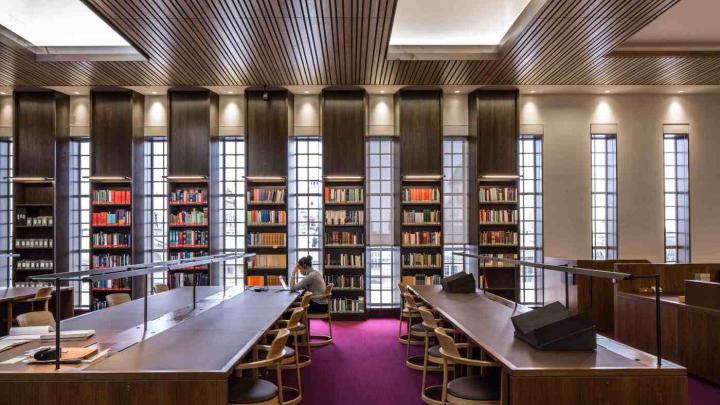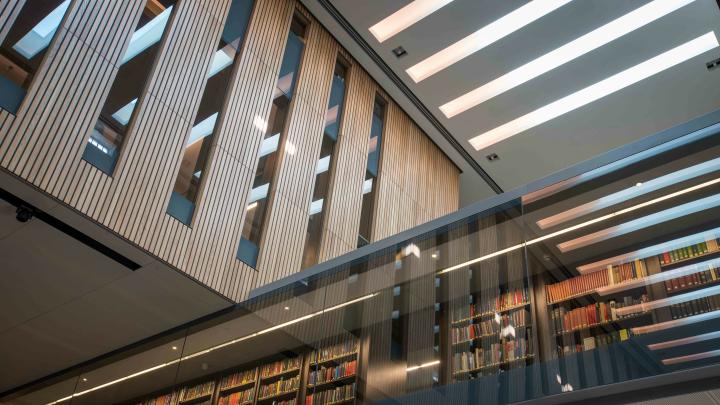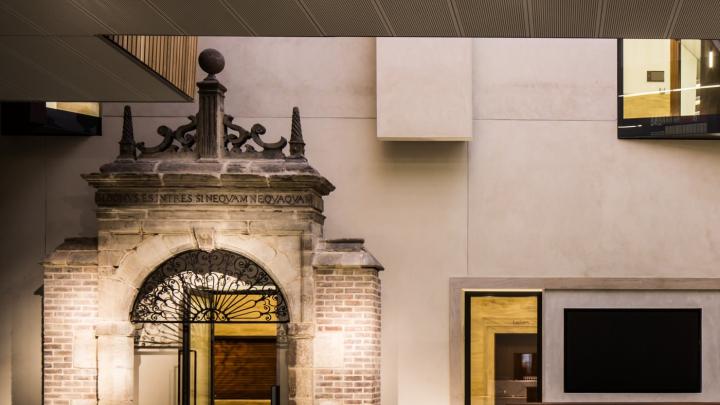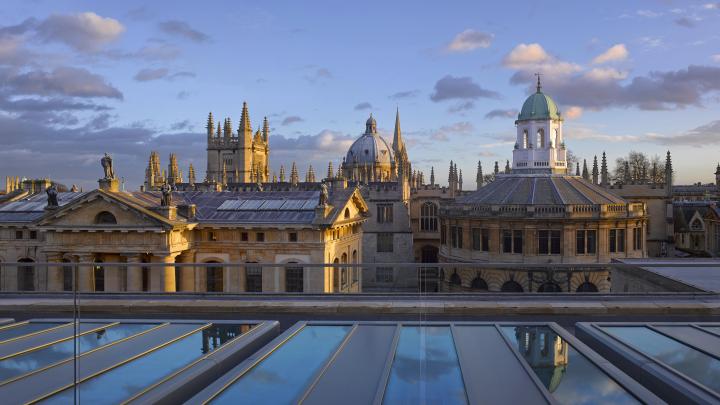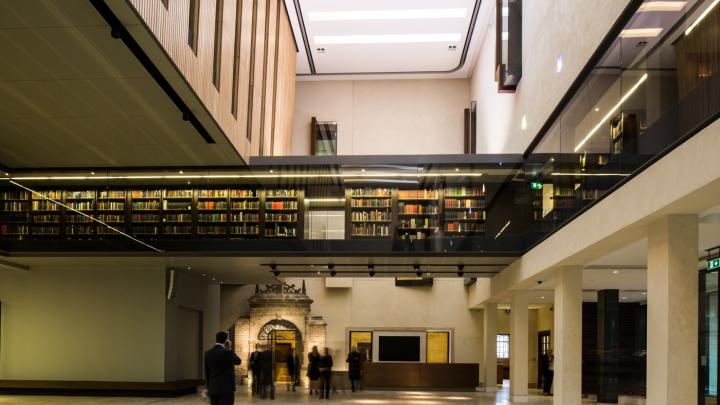What should a home for old books look like in a digital age? The Harvard Library has grappled with this issue (see “Gutenberg 2.0”). Now, the University of Oxford has unveiled its attempt to answer that question in the form of the Weston Library, its new facility for reading, teaching, exhibiting, and digitizing the Bodleian Library system’s rare materials and special collections. The £80-million, five-year construction project transforms the interior of the building once known as the “New Bodleian” (which served mainly as a book depository with some reading rooms and office space attached) into a somewhat eclectic mix of spaces deemed vital parts of a twenty-first-century rare books library: a cavernous exhibition hall, a lecture theater, digital-ready classrooms, conservation and imaging workshops, office space for visiting scholars, a café, and (of course) stacks and reading rooms—all in six aboveground stories, with three more staff-only stories of underground stacks.
It’s impressive, but the question of how it all hangs together as a single library highlights the challenges of purpose and self-definition that big university libraries have faced in the past two decades. Digitization is important, but no one is going to pulp a copy of Shakespeare’s First Folio because a scan is available. Yet a rare book locked out of view isn’t especially helpful to anyone. The problem—both of design and function—is how best to allow access to the books people want to see—people as different as a day-tripper and a tenured professor. The goal from the outset was to create “better interactions between manuscript archives, rare books, and people,” says Richard Ovenden, Bodley’s Librarian since 2014. (Ovenden succeeded Sarah Thomas, who is now vice president for the Harvard Library; much of the planning and construction for the Bodleian project happened during her librarianship at Oxford.)
In the case of the Weston Library, that means that the renovated structure has evolved into a space that may not look like a library at first glance. Architect Jim Eyre of the firm Wilkinson Eyre has created an enormous atrium that greets visitors who step in off Broad Street; it suggests more the grandeur of a museum than the quiet of a library, and this is deliberate. A glass-walled halo of stacks hovers above the hall, but the most notable features are a café and walls outfitted with two looming 70-inch Samsung touch-screen displays. There are two exhibition galleries at the back: the “Treasury” will keep some of the University’s most famous items (e.g., the Magna Carta, the Gutenberg Bible, the First Folio) on semi-permanent display; the other will house special exhibitions (previously relegated to an inconspicuous corner of the Bodleian’s Old Schools quad). This is the new public face of the Bodleian—the library as commons, a way of displaying the University’s treasures to visitors rather than hiding them from view. (Once open, it will be the single largest indoor space at Oxford.)
The apparatus of scholarly life, however, is attached to this visitor-friendly face. The side entrance on Parks Road leads to the lockers and admissions desks familiar to users of any rare-books library. After you’ve cleared the gate, beautiful new reading rooms open up level by level; an especially gorgeous one on the top floor lets abundant daylight in through UV filters of the kind increasingly popular in museums. Especially notable in the redesign is the decision to incorporate teaching facilities into the library’s spaces. A lecture theater was seen as “essential,” and five seminar rooms of various sizes dot the first floor—somewhat unusual at Oxford for any building that’s not a college. A room labeled “Centre for Digital Scholarship,” outfitted with six large computer monitors, awaits use.
There is a notable division between public and research spaces in the library, for understandable reasons of security; and, as in most rare-books libraries, there is a further division between the space occupied by researchers and the space accessed by staff. But the variety and scale of different kinds of contact with materials—only some of them books—offered visitors is especially noteworthy in the new Weston Library: not just reader-book contact, but the dramatic display of heritage items in low-light public rooms, the curated display of exhibitions, the didactic display possible in classrooms, and the long-distance online display of digitized objects. The Weston is definitely a hybrid (a rather majestic, sleekly designed hybrid, thanks to brilliant architecture); part of what it points out to other research universities is that a rare-book library now must be purpose-built to serve a variety of functions simultaneously. The traditional reading room is only one.
